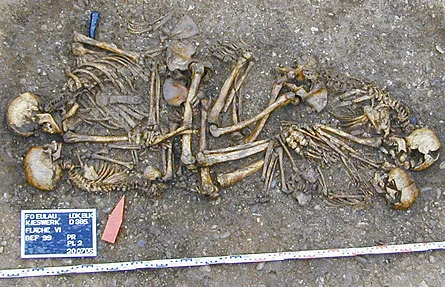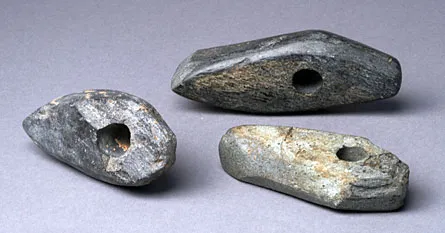Exhuming a violent event
Scientists glean clues to a lethal prehistoric raid from skeletons excavated at a German site
Thirteen people who perished around 4,600 years ago still have something to say about life and death in prehistoric Europe.


Analyses of their skeletal remains, found in 2005 in four large graves at a German Neolithic-era site called Eulau, provide a rare opportunity to reconstruct a lethal encounter from Europe’s Corded Ware culture, say anthropologist Christian Meyer of the University of Mainz in Germany and his colleagues. Between about 4,800 and 4,000 years ago, Corded Ware farmers and cattle-raisers spread across central and eastern Europe.
Reconstruction of the events at Eulau also offers a rare peek into the motivation for putting two or more bodies in the same grave, the researchers report in a paper published online August 15 in the Journal of Anthropological Archaeology. Little is known about several dozen similar Corded Ware graves that have been excavated.
The 13 men, women and children whose remains were unearthed at Eulau in 2005 apparently stayed behind unprotected when their fellow villagers briefly left for some reason. Unknown attackers then killed them with bows, arrows and stone axes, the researchers report.
After the attackers left, villagers returned to find their compatriots murdered. Four large graves were dug close together, each containing a carefully arranged group of two to four people. Genetic evidence, published in the Proceedings of the National Academy of Sciences in 2008, suggests that one grave held a nuclear family — a man, a woman and their two children. The man was placed beside an 8- to 9-year-old boy, while the woman was next to a 4- to 5-year-old boy.
Other graves at the site probably contained biologically related adults and children, in the scientists’ view. Villagers also put pottery and stone artifacts in the graves.
“Until now, it was only possible to speculate about the significance of these graves and who was included in them,” Meyer says.
At Eulau, as at several previously excavated Neolithic mass graves, “the attackers seem to have been members of the same cultural group, perhaps neighbors,” remarks anthropologist T. Douglas Price of the University of Wisconsin–Madison.
In the 2008 paper, Meyer’s group reported that mitochondrial and nuclear DNA extracted from the Eulau skeletons identified a biological family in one grave and a pair of siblings in another. Chemical profiles of the Eulau individuals’ teeth, which indicate what they ate early in life, suggested that only the men and children had been raised locally.
That fits with a social structure in which descent was traced through the father’s line and men paired with women who came from other groups, the researchers say.
Five of the Eulau skeletons—two men, two women and a boy—display head and bodily injuries caused by a violent attack, the team reports in their new paper. Two stone arrowheads were found with one woman’s skeleton. Other violent injuries may have escaped notice because all 13 of the skeletons have lain in blocks of soil at a German museum since their discovery, making a complete analysis impossible.
Both slain Eulau men had also suffered left-arm damage from earlier falls that interfered with wrist and hand movement. Meyer speculates that, because of those infirmities, the men had stayed behind with women and children the day the raid occurred.
A 7,000-year-old Neolithic mass grave in southern Germany includes a man, a women, two children and an older women who were buried together and probably formed a biological family, notes anthropologist R. Alexander Bentley of Durham University in England. Dental data indicate that the grave contains no local women, who were presumably captured by attackers.
Male-centered kinship prompted conflicts between neighboring groups during the Neolithic period, and possibly at Eulau, Bentley theorizes.







